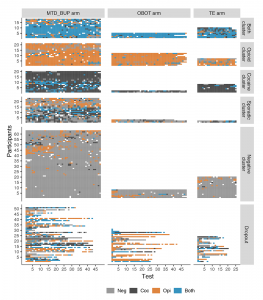Featured Paper of the Month – May 2021

See full caption below. Click image to enlarge.
Published in Psychopharmacology by Leigh V Panlilio, et al. in the NIDA IRP Real-world Assessment, Prediction, and Treatment Unit.
Summary
Despite the popular conception that people in treatment for opioid addiction either become abstinent or relapse into a spiral of continuous drug use, many actually continue using drugs to some intermediate degree. Some use drugs frequently, some use sporadically, and some use very rarely. In this paper, we show that groups of people who share similar patterns of use also tend to be alike in other ways. For example, we find that those who use sporadically are unusual in that they do not seem to be driven by drug craving, but tend to use simply because they were offered drugs. In contrast, craving typically does precede drug use in people who use frequently and also in those who only use very rarely. We also found differences in how people reacted to stressful events: craving generally increased when people were stressed, but this increase was greater in those who were using drugs frequently. These findings are helping us develop ways to discuss treatment outcome in clear and meaningful ways for the majority of people in treatment, given that, as we noted, the usual outcome is neither total abstinence nor ongoing near-continuous use. Beyond that, the findings could also eventually help inform personalized strategies for treatment augmentation.
Figure Caption: Patterns of opioid and cocaine use in individual participants in the three arms of the study. Each small cell represents the results of a single drug test, which could be negative for opioids and cocaine (gray), positive only for cocaine (black), positive only for opioids (orange), positive for both opioids and cocaine (blue), or missing (white). Each row of tests represents the sequence of test results for one participant. Each larger block of sequences represents a cluster of participants who were identified as having similar patterns of use, or who left the study early (Dropout).
Publication Information
In: Psychopharmacology, 2021, ISBN: 1432-2072.
